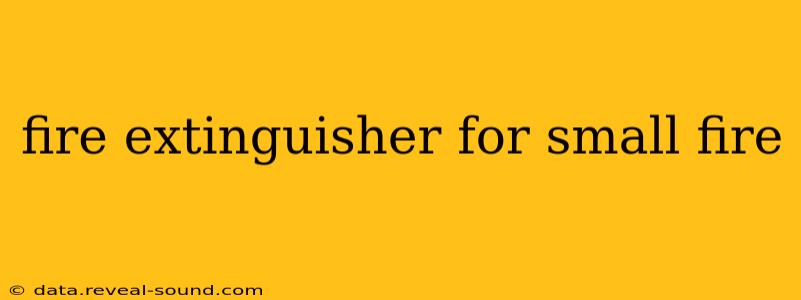Small fires can quickly escalate into major emergencies, causing significant property damage and even posing life-threatening risks. Knowing how to effectively tackle a small fire using the right fire extinguisher can be the difference between a minor incident and a catastrophic event. This guide will equip you with the knowledge to choose and use the appropriate fire extinguisher for small fires in your home or workplace.
What Type of Fire Extinguisher is Best for Small Fires?
The best fire extinguisher for small fires depends entirely on the class of fire. Fire classes categorize fires based on the burning material, and each class requires a different extinguishing agent. Understanding these classes is crucial for selecting the right extinguisher.
-
Class A: These fires involve ordinary combustible materials like wood, paper, cloth, and plastic. Water is generally effective against Class A fires.
-
Class B: These fires involve flammable liquids like gasoline, oil, grease, and paint. These fires require extinguishing agents that can interrupt the combustion process, preventing reignition.
-
Class C: These fires involve energized electrical equipment like appliances, wiring, and electrical panels. Using water on a Class C fire is extremely dangerous and can lead to electrocution. Specialized extinguishing agents are necessary.
-
Class D: These fires involve combustible metals like magnesium, titanium, and sodium. These fires require specialized extinguishing agents and often require professional intervention.
-
Class K: These fires involve cooking oils and fats. These fires require special extinguishing agents designed to prevent reignition and cool the burning oil quickly.
For many small home fires, a multi-purpose ABC extinguisher is a good starting point. This type of extinguisher is effective against Class A, B, and C fires. However, it's crucial to understand the limitations. A single ABC extinguisher may not be suitable for all scenarios, particularly larger fires or those involving Class K materials.
What Size Fire Extinguisher Do I Need for a Small Fire?
The size of the extinguisher you need is determined by the size and type of fire you anticipate. Smaller extinguishers (2A10BC or similar rating) are suitable for small, contained fires, while larger extinguishers may be needed for larger areas or more intense flames. Always check the extinguisher's rating to ensure it's appropriate for the potential fire size. Never attempt to extinguish a fire that is spreading rapidly or beyond your control. Your safety is paramount; evacuate immediately and call emergency services.
How Do I Use a Fire Extinguisher for a Small Fire? (PASS Method)
Remember the PASS method:
- Pull the pin: Remove the safety pin.
- Aim at the base of the fire: Direct the nozzle at the bottom of the flames, not the top.
- Squeeze the lever: Squeeze the handle to release the extinguishing agent.
- Sweep from side to side: Move the nozzle back and forth to cover the entire area of the fire.
What are the Different Types of Fire Extinguishers?
Besides the ABC extinguisher mentioned earlier, several other types exist, each suited to specific fire classes:
- Water Extinguishers: Effective against Class A fires.
- Foam Extinguishers: Effective against Class A and B fires.
- Carbon Dioxide (CO2) Extinguishers: Effective against Class B and C fires.
- Dry Chemical Extinguishers: Effective against Class A, B, and C fires (various types exist).
- Wet Chemical Extinguishers: Specifically designed for Class K fires (cooking oils and fats).
How Often Should I Inspect My Fire Extinguisher?
Regular inspection is vital. Check your extinguisher monthly for any signs of damage, corrosion, or low pressure. Have it professionally inspected and serviced annually by a qualified technician.
Where Should I Place Fire Extinguishers in My Home?
Strategically place fire extinguishers in easily accessible locations throughout your home, especially near potential fire hazards like the kitchen and garage. Ensure everyone in your household knows their location and how to use them.
What Should I Do After Using a Fire Extinguisher?
After using a fire extinguisher, immediately call emergency services even if you believe the fire is out. They can confirm the fire is completely extinguished and check for any lingering hazards. The used extinguisher needs to be recharged or replaced by a qualified professional.
Remember, prevention is key. Regular maintenance, working smoke detectors, and a well-rehearsed escape plan are crucial for fire safety. This guide provides a starting point; always prioritize your safety and consult local fire safety regulations for specific guidance.
